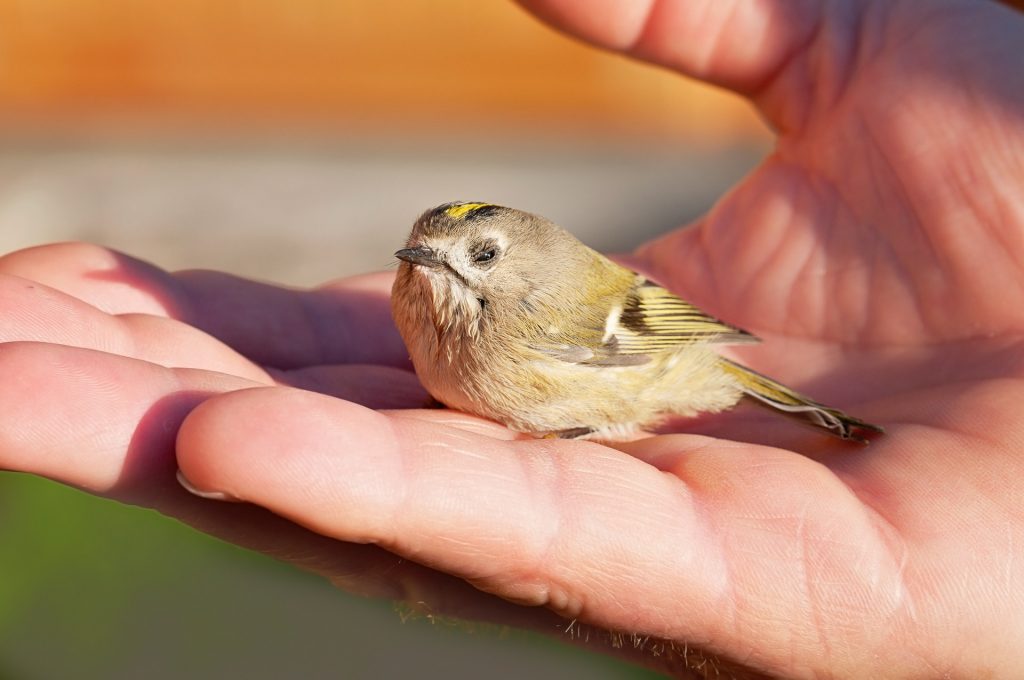
Introduction
Most animal sanctuaries receive daily requests to take in animals in need of humanitarian help. Whilst every animal rescueAn organization that helps secure animals from dangerous or unacceptable situations. As organizations, rescues may or may not have dedicated permanent infrastructure for housing animals. would probably like to say “yes” to these requests, reality often requires a different response. Every animal sanctuary has limited capacity for responsible care and it’s vitally important to the health and happiness of their current residents and the longevity of the sanctuary to recognize and comply with those limitations. In addition to limited capacity, many animals in need also often fall outside the scope of sanctuaries’ missions. In this resource, we’re going to review some of the different ways you can manage these requests without putting your organization, your staff, and your residents at risk.
When and How to Say “No”
Saying “no” is almost never easy, but there are ways to make it more manageable.
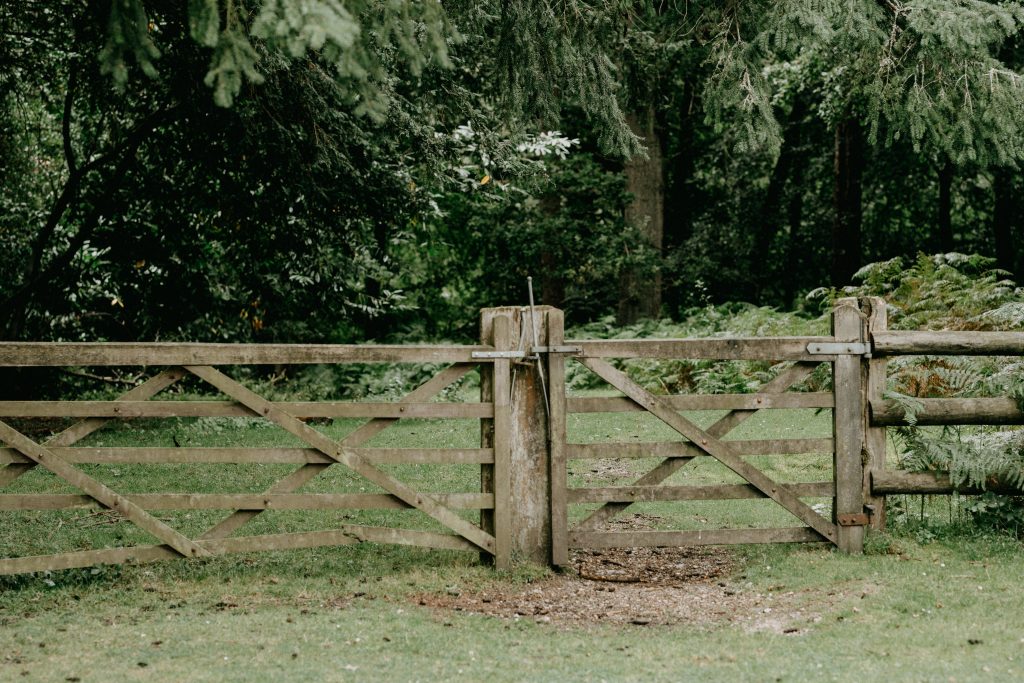
Create an Effective Rescue Policy
Consider creating an effective rescue policy that’s accessible to the public and explains your limitations and criteria for taking in an animal, including the specific species your sanctuary is currently able to responsibly care for.
Learn How to Recognize and Manage Compassion Fatigue and Burnout
Compassion fatigue and burnout are linked to a pervading sense that “you must do everything you can to help another, even if it’s at the expense of your own mental and physical health”. Left unmanaged, they can have deleterious effects on your staff, residents, and organization. There will always be animals in need, but it’s important to recognize that they will not be well-served by an organization that does not take care of itself. Learning how to recognize and manage burnoutA physical and emotion reaction to prolonged, unmanaged workplace stress. and compassion fatigueA form of Secondary Traumatic Stress Disorder that can affect anyone serving individuals who have experienced or are currently experiencing trauma. will make it easier to politely say “no”, especially to the more challenging requests for help.
Create a Rescue and Referral Network
Create a rescue and referral network so you can kindly say “no” and lead these requests for help to other animal rescuesOrganizations that help secure animals from dangerous or unacceptable situations. As organizations, rescues may or may not have dedicated permanent infrastructure for housing animals. that do take in that specific species and would be comfortable with people reaching out to them. Having a good relationship with a local companion animalAn animal who spends regular time with humans in their home and life. Typically cats and dogs are considered companion animals, though many species of animals could also be companion animals. rescue and a wildlife rehabilitator is also very helpful.
Provide Mutual Support
If you are able, consider donating to the organization or rehabber that agrees to take in the animals that are outside of your sanctuary’s scope. Like many farmed animal sanctuariesAnimal sanctuaries that primarily care for rescued animals that were farmed by humans., companion animal rescues and wildlife rehabilitators are often overwhelmed and under-resourced. A lot of effort goes into rescuing and rehabbing companion animalsAnimals who spend regular time with humans in their home and life. Typically cats and dogs are considered companion animals, though many species of animals could also be companion animals. and wild animals in distress!
Refer Them to The Open Sanctuary Project
You can always refer these requests to The Open Sanctuary Project’s website for information on temporary and/or permanent housing and care for a particular farmed animalA species or specific breed of animal that is raised by humans for the use of their bodies or what comes from their bodies. species. With the right resources and guidance, there is the possibility that the person or group requesting your help can responsibly provide long-term care for the animal(s) in need.
Biosecurity Risks
Bringing animals that are outside the scope of your mission into your facilities could put your residents and organization at risk. With the current risk of highly pathogenic avian influenza (HPAI), a serious threat to all avian species, it is optimal to quarantine rescues off-site for thirty days, ideally in a home without other birds. However, if you do not have this option, please make sure that you safely observe biosecurity measures to protect your existing avian residents! If you are operating in an HPAI control zone, you absolutely must not bring birds in. If you are unable to follow proper biosecurity measures, saying “no” is vitally important to the safety of your staff and current residents.
Is it Illegal?
Some zoning laws limit the kinds of species your sanctuary can legally care for. Similarly, requests to take in and help wild animals in distress should be considered very carefully. It is a violation of state and federal law for members of the public to hold most species of wild animals in captivity. However, members of the public are permitted to rescue wild animals in distress and house them very temporarily, but they must transfer them as soon as possible to a properly permitted wildlife rehabilitator. It’s important to understand your state and local laws around this and make sure you are meeting all requirements.
Saying “Yes” to Temporary Help and Housing
If you say yes to temporarily housing animals outside your sanctuary’s scope, contact an appropriate animal sanctuary, companion animal shelterAn organization, either government-funded and maintained or not-for-profit and funded by charitable contributions, with a physical infrastructure in which homeless animals are cared for and offered for adoption., or wildlife rehabilitator immediately.
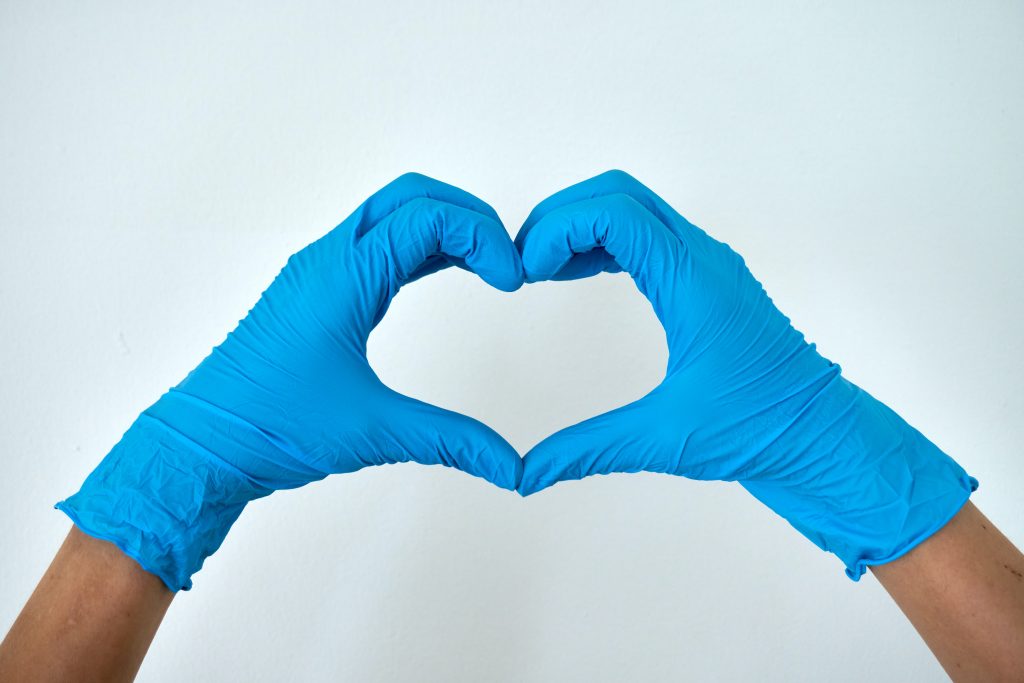
Online Resources to Help You Locate a Wildlife Rehabilitator
Animal Help Now
Humane Society of the U.S. “How to Find a Wildlife Rehabilitator”
National Wildlife Rehabilitators Association (NWRA) “Finding a Rehabilitator” or call them at 320-230-9920
The International Wildlife Rehabilitation Council
Contact your local animal control bureau, state wildlife agency, or wildlife rehabilitator
If you cannot get a hold of someone right away, please remember that like you, these folks are extremely busy. Sometimes it can take several hours to receive a call back. In the meantime, try contacting another professional and remain as calm as possible. If the animal in distress is on your property and has not been captured yet, it’s best to wait for detailed guidance from a local professional. Your safety comes first! However, if you must handle an animal in need of immediate assistance, there are some professional tips for temporarily handling different wildlife species below.
If the animal has already been contained, follow proper biosecurity measures. For the safety of your residents and your staff, all incoming animals must be isolated, and strict disinfection and quarantineThe policy or space in which an individual is separately housed away from others as a preventative measure to protect other residents from potentially contagious health conditions, such as in the case of new residents or residents who may have been exposed to certain diseases. procedures must be followed. If you decide to take in animals outside the scope of your missionThe stated goals and activities of an organization. An animal sanctuary’s mission is commonly focused on objectives such as animal rescue and public advocacy. intermittently, keep an isolationIn medical and health-related circumstances, isolation represents the act or policy of separating an individual with a contagious health condition from other residents in order to prevent the spread of disease. In non-medical circumstances, isolation represents the act of preventing an individual from being near their companions due to forced separation. Forcibly isolating an individual to live alone and apart from their companions can result in boredom, loneliness, anxiety, and distress. area available to keep them away from incumbent and current residents. A fence alone is an insufficient barrier because many diseases are airborne. Anyone who comes into contact with an isolated individual must follow strict protocol. This can include an isolation suit, boots or boot covers, gloves or hand disinfectant, foot bathes, and if there is fear of airborne disease, masks. Please see our resources “Practical Biosecurity Measures for Animal Sanctuaries” and “Establishing Safe and Effective Quarantine and Isolation Protocols for Your Animal Sanctuary” for more in-depth information on this topic.
Keep Records!
Remember to keep records of all intakes, even if they are only housed on your property temporarily. This is important for any federal or state legal inquiries and biosecurity protocols.
What to Know While You’re Waiting for a Wildlife Rehabilitator
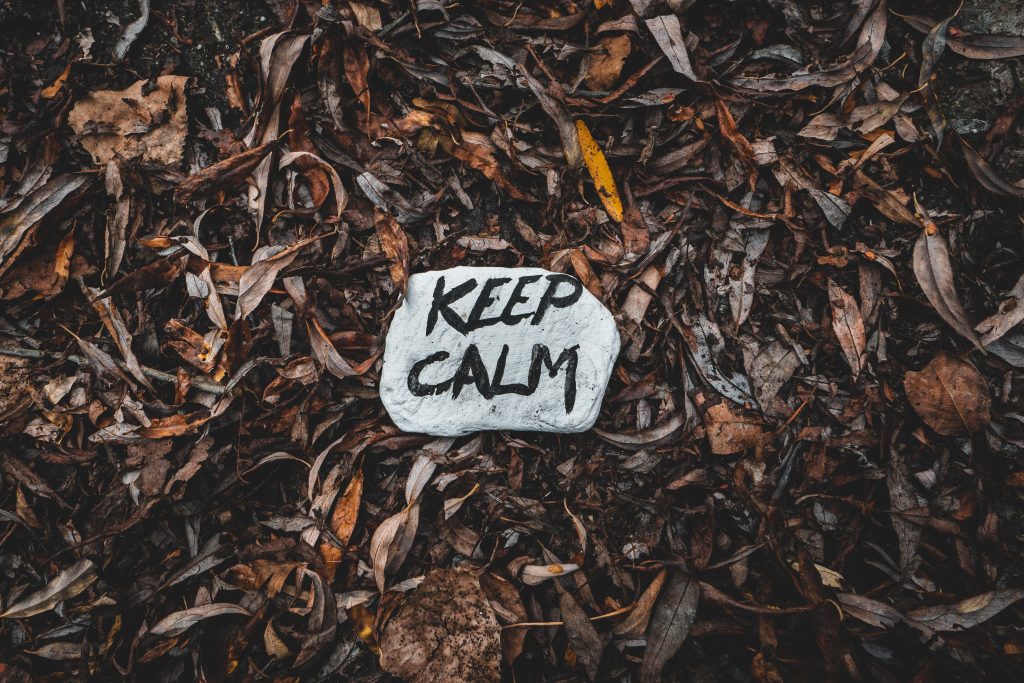
A Note on Laws Regarding Wildlife
The advice expressed in this resource is to be utilized at your own discretion. Laws regarding wildlife may differ between regions, counties, states, and countries. Therefore, it’s important to understand your state and local laws regarding temporarily helping and housing wildlife and make sure you are meeting all requirements.
Help! I Found a Baby Wild Animal

If someone finds a baby wild animal near or on your property that appears to be in distress, you’ll first need to determine whether they really need help. Many baby wild animals that appear to be abandoned or in need of help are simply waiting for their parents to return. Adult wild animals frequently leave their babies in well-hidden spots for hours at a time to forage for food and hide them from potential predators. This is completely normal behavior and in almost all cases, the parents will return. However, if you find a visibly sick or injured baby wild animal or notice that their parents have not returned for over 24 hours, please contact a wildlife rehabilitator right away. Be mindful: When humans handle or move baby wild animals, their parents may not be able to find them when they return.
Still Unsure?
Check out these external resources for further guidance:
“I Found a Baby Mammal, Now What?” , National Wildlife Rehabilitators Association
“I Found a Baby Bird, Now What?”, Animal Haven Wild Bird Rehabilitation Center
“Making a Substitute Bird’s Nest”, Louisiana Department of Wildlife and Fisheries
“What to Do if You Find Baby Wildlife”, National Wildlife Federation
“Baby Mammals”, Rideau Valley Wildlife Sanctuary
Help! I Found a Small Wild Bird
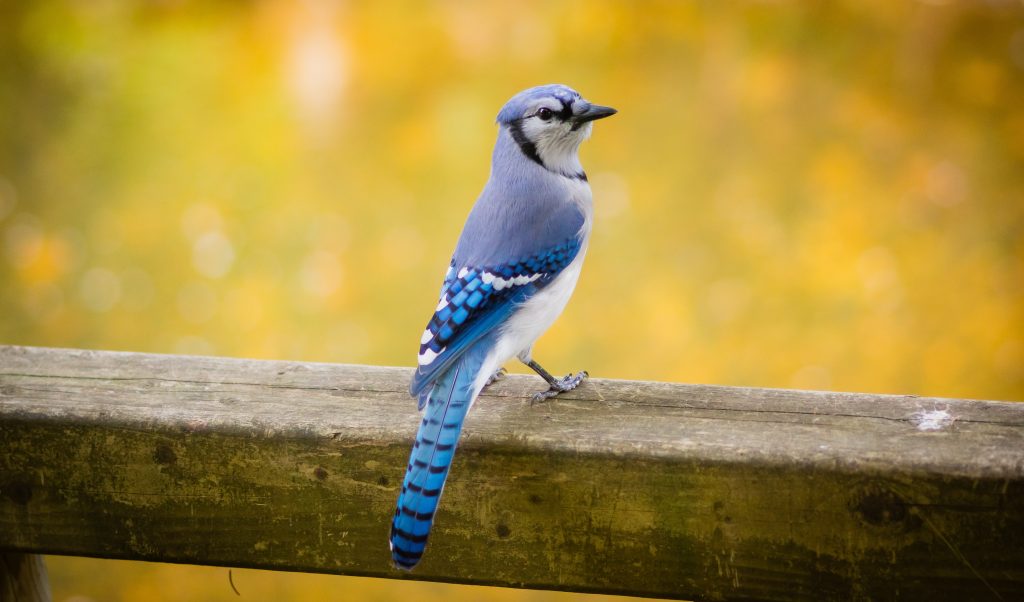
If you find a small injured or sick bird (e.g. songbirds, woodpeckers, hummingbirds, crows, pigeons, jays, etc.) that is not a raptor (e.g. hawk, eagle, falcon, etc.), waterfowl species (e.g. gooseUnless explicitly mentioned, we are referring to domesticated goose breeds, not wild geese, who may have unique needs not covered by this resource., swan), or wading bird (e.g. heron, bittern, egret), prepare a cardboard box, paper bag, or petAn animal who spends regular time with humans in their home and life for companionship or human pleasure. Typically a small subset of animal species are considered to be pets by the general public. carrier with small air holes to put the bird in once they have been rescued. You can spread newspaper or paper towels on the bottom of the carrier, but NOT regular bath towels. Bird claws will get caught in the fabric and they can injure themselves trying to break free. With thin disposable gloves, quietly approach the bird from behind, restrain their wings by holding the bird firmly between your hands, and quickly put them in the carrier. If you have a towel, you can throw it over the bird, carefully restrain their wings, and put them in the carrier. Do not hold or carry the bird by their wings, head, or feet. This can harmThe infliction of mental, emotional, and/or physical pain, suffering, or loss. Harm can occur intentionally or unintentionally and directly or indirectly. Someone can intentionally cause direct harm (e.g., punitively cutting a sheep's skin while shearing them) or unintentionally cause direct harm (e.g., your hand slips while shearing a sheep, causing an accidental wound on their skin). Likewise, someone can intentionally cause indirect harm (e.g., selling socks made from a sanctuary resident's wool and encouraging folks who purchase them to buy more products made from the wool of farmed sheep) or unintentionally cause indirect harm (e.g., selling socks made from a sanctuary resident's wool, which inadvertently perpetuates the idea that it is ok to commodify sheep for their wool). them. If you do not have gloves, it’s generally OK to use your bare hands to pick up small birds. Most bird diseases are specific to birds and cannot be transmitted to humans. Birds cannot get rabies! Just be sure to wash your hands thoroughly with soap after you’re done handling them.
Once you’ve contained the bird, put them in a warm, dark, quiet place until a wildlife rehabilitator can take them. Handle the bird as little as possible. Do not disturb them or repeatedly uncover and check on them. No matter how kind you are, the bird sees you as a predator and any human handling is extremely stressful for them. Do not let children or other companion animals near them.
Window Strikes
If you know the bird hit a window or building, there is a good chance they are just stunned and will make a full recovery on their own. You can keep them in a carrier for an hour and then, as far away from any buildings or windows as possible, release them. If they are still disoriented or cannot fly, please contact a wildlife rehabilitator.
Help! I Found a Raptor

A raptor or bird of prey is a carnivorous bird that has a hooked beak, sharp talons, and keen eyesight (e.g. hawk, eagle, falcon, etc.). If you find an injured raptor, please contact a wildlife rehabilitator right away. Do not attempt to care for them on your own. If you must handle a raptor, prepare a cardboard box that is slightly larger than the bird and cut small air holes near the base of it. You can cover the bottom of the box with a small sheet if you’d like, but do not use a towel, hay, or straw to cover the bottom. The towel will get caught in their talons and the straw and hay can expose the raptor to deadly fungi. Please never use a wire cage to transport or hold an injured raptor in. Wire cages can cause severe damage to their feathers and wings. Wearing long, heavy, preferably Kevlar-lined gloves, you can quietly approach the bird from behind (if possible) and cover their entire head and body with a blanket, towel, or jacket. BE VERY MINDFUL of where their talons are and quickly restrain them. Then, fold and firmly hold their wings against their body into a normal, relaxed position. They should begin to calm down, but your hold should remain firm. Their talons are their main method of protection and they are very sharp and powerful, so carefully place the bird in the box, then take off the towel and secure the lid. Leave the raptor in the box in a warm, dark, quiet place until a wildlife rehabilitator can take them. Do not disturb them or repeatedly uncover and check on them. No matter how kind you are, the bird sees you as a predator and any human handling is extremely stressful for them. Do not let children or other companion animals near them.
Help! I Found a Wild Waterfowl Species, Wading Bird, or Shorebird

If you find an injured or sick waterfowl species, wading, or shorebird (e.g. wild duckUnless explicitly mentioned, we are referring to domesticated duck breeds, not wild ducks, who may have unique needs not covered by this resource., goose, swan, heron, bittern, loon, gull, etc.), please call a wildlife rehabilitator right away. While ducksUnless explicitly mentioned, we are referring to domesticated duck breeds, not wild ducks, who may have unique needs not covered by this resource. may be relatively manageable to capture and hold temporarily, heavier aquatic birds like swans and wading birds with long sharp beaks like bitterns can be VERY dangerous to handle. If you must handle a wading bird that is unresponsive, immobile, or in need of immediate assistance, please prepare and protect yourself first. It is still highly recommended to call a wildlife rehabilitator and wait for their response. It is of utmost importance to protect yourself and call people who are professionally trained to handle wading birds and shorebirds. When dealing with large waterfowl species, wading birds, and shorebirds, you must wear long thick gloves, heavy clothing, and eye goggles to protect yourself from being stabbed. Large waterfowl species like geeseUnless explicitly mentioned, we are referring to domesticated goose breeds, not wild geese, who may have unique needs not covered by this resource. and swans are heavy and very strong. Their wings are very powerful and can cause serious damage. Prepare a large crate or box with several small air holes, lined with newspaper or a sheet. Then, quietly approach the bird from behind (if possible) and cover their entire head and body with a blanket, towel, or jacket. If you are dealing with a wading bird or shorebird, BE VERY MINDFUL of where their beaks are and gently, but firmly take hold of their beak with one hand. Then, use your other hand to fold their wings and cradle their body under your arm. They should begin to calm down, but your hold around their beak and body should remain firm. Immediately place them inside the box, quickly take off the towel and secure the lid. Leave the bird in the box in a warm, dark, quiet place until a wildlife rehabilitator can take them. Do not disturb them or repeatedly uncover and check on them. No matter how kind you are, the bird sees you as a predator and any human handling is extremely stressful for them. Do not let children or other companion animals near them.
Help! I Found a Stray DomesticatedAdapted over time (as by selective breeding) from a wild or natural state to life in close association with and to the benefit of humans Bird
For tips and strategies on how to safely catch or contain a loose domesticated bird in need of assistance, please check out part one, part two, part three, and part four of our resource series titled “A Guide to Safely Catching Stray Birds for Your Animal Sanctuary or Rescue”.
Help! I Found a Squirrel
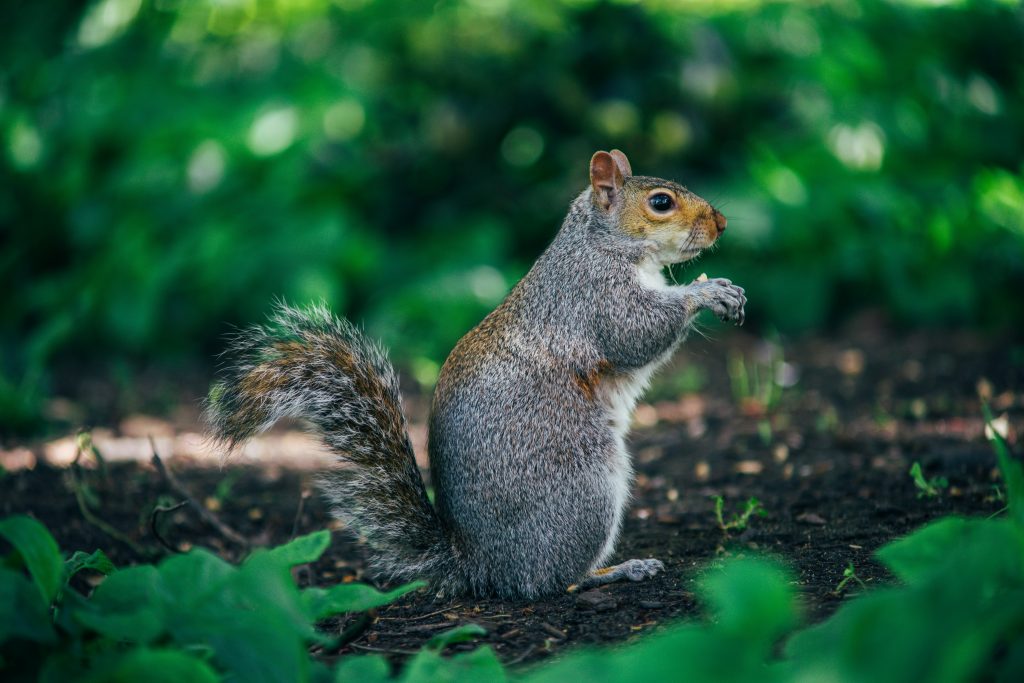
If you find an injured or sick squirrel, please do not try to pick them up with your bare hands. Contact a wildlife rehabilitator right away for guidance. Although they are cute, squirrels have very long, sharp teeth and strong jaws, which they use to bite when they are in a defensive state. If you do not hear back from a wildlife rehabilitator right away, there are a few different ways to contain a squirrel while you wait. It’s safest to try an indirect method first:
The “Spider” Method
First, gather a sturdy container (e.g. pet carrier or cardboard box with several small air holes, a stiff piece of cardboard, plastic, or wood, a plush blanket or soft old shirt, and duct tape, rope, or bungee cords. Approach the squirrel calmly and quietly until you are close enough to throw a plush blanket over top of them, covering their eyes, head, and body. Then, place the container over top of them. Slide the stiff piece of cardboard, plastic, or wood under the container and use the duct tape, rope, or bungee cords to secure the bottom of the container.
The “Scootch” Method
First, prepare a cardboard box or sturdy container and place it on its side near the injured squirrel. Then, use a broom or tree branch to gently nudge the squirrel inside the container. Once they are inside, find a safe way to secure the lid.
If you must handle a squirrel with your hands, it’s best to use Kevlar-lined gloves to keep their teeth from potentially breaking your skin. Squirrel bites are hard enough to break through thinner gloves and injure your hands. Quietly approach the squirrel and throw a plush blanket or soft shirt over top of them. Then, quickly scoop them up and place them in a sturdy container so they are comfortable. Leave the blanket inside the container and the squirrel will have something to snuggle and hide under. Do NOT line the container with a bath towel or paper towels. Squirrels will injure themselves when they get their claws caught in the towel and rip the paper towels to shreds. The box must have air holes and the lid must be secure if there is an active squirrel inside. They can easily jump and push the top off of a box.
Once you’ve contained the squirrel, put them in a warm, dark, quiet place until a wildlife rehabilitator can take them. Handle them as little as possible. Do not disturb them or repeatedly uncover and check on them. No matter how kind you are, the squirrel sees you as a predator and any human handling is extremely stressful for them. Do not let children or other companion animals near them.
Help! I Found a Chipmunk, Mouse, or Rat
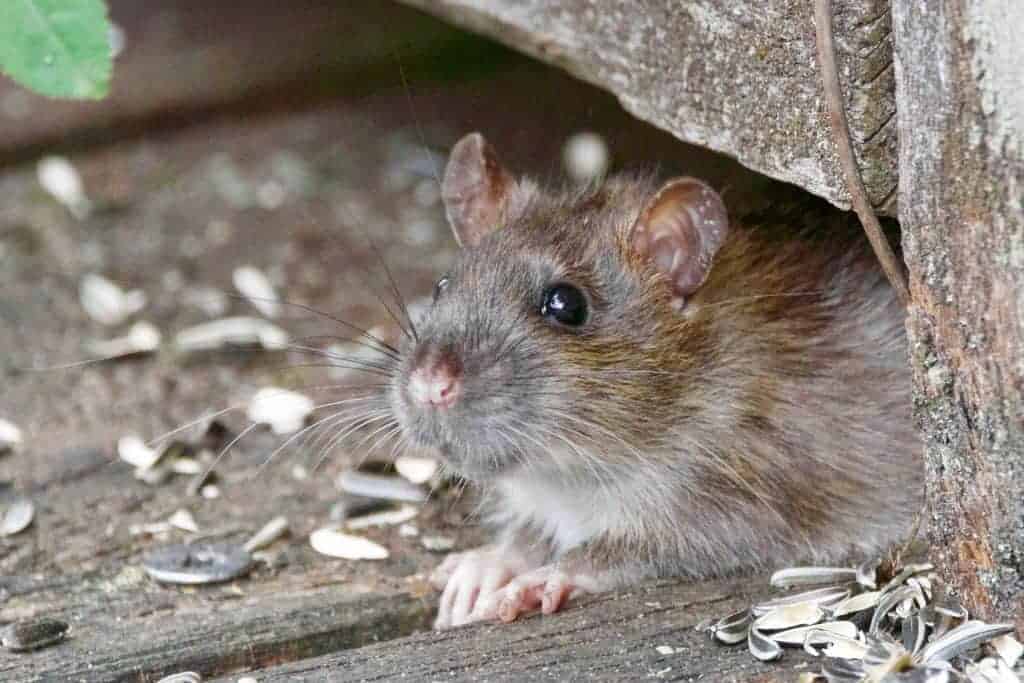
If you find an injured or sick chipmunk, mouse, or rat, please do not try to pick them up with your bare hands. Like squirrels, chipmunks, mice, and rats have very sharp teeth and will bite you when they feel threatened. Call a licensed wildlife rehabilitator right away. If you do not hear back from a wildlife rehabilitator right away, there are a few different ways to contain them while you wait. It’s safest to try an indirect method first:
The “Spider” Method
First, gather a sturdy container (e.g. pet carrier or cardboard box) with several small air holes, a stiff piece of cardboard, plastic, or wood, a plush blanket or soft old shirt, and duct tape, rope, or bungee cords. Approach the chipmunk, mouse, or rat calmly and quietly until you are close enough to throw a plush blanket or soft shirt over top of them, covering their eyes, head, and body. Then, place the container over top of them. Slide the stiff piece of cardboard, plastic, or wood under the container and use the duct tape, rope, or bungee cords to secure the bottom to the container.
The “Scootch” Method
First, prepare a cardboard box or other sturdy container and place it on its side near the injured chipmunk, mouse, or rat. Then, use a broom or tree branch to gently nudge them inside the container. Once they are inside, find a safe way to secure the lid.
If you must handle them with your hands, prepare a small container (e.g. cardboard box, shoebox, or pet carrier) with small air holes on the lid and gather a plush blanket or soft shirt and a pair of thick gloves (preferably Kevlar-lined) to wear. Quietly approach the chipmunk, mouse, or rat and throw the blanket or shirt over top of them. Scoop them up and place them in the container as quickly and gently as possible. Leave the blanket inside the container and they will have something to snuggle and hide under. Do NOT line the container with a bath towel or paper towels. They can injure themselves when they get their claws caught in the towel and will rip the paper towels to shreds.
Once you’ve contained them, secure the container’s lid and put them in a warm, dark, quiet place until a wildlife rehabilitator can take them. Handle them as little as possible. Do not disturb them or repeatedly uncover and check on them. No matter how kind you are, chipmunks, mice, and rats see you as a predator and any human handling is extremely stressful for them. Do not let children or other companion animals near them.
Help! I Found an Opossum
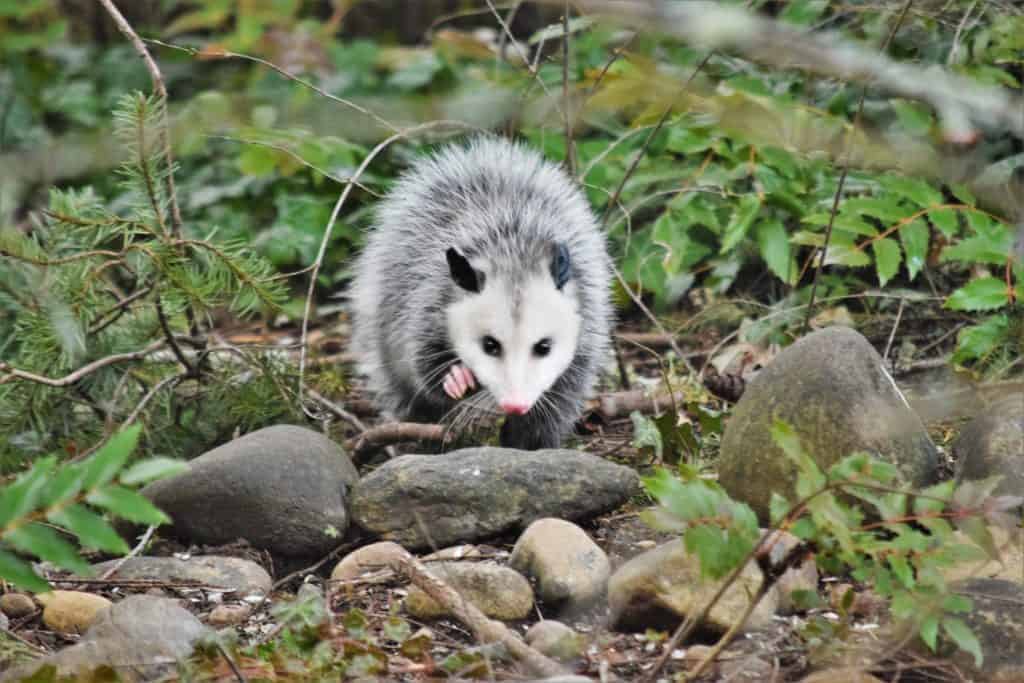
If you find an injured or sick opossum, DO NOT try to pick them up with your bare hands. Though they are usually nonaggressive, opossums can become aggressive when they feel frightened. At the very least, they will probably hiss and excrete a foul-smelling green gel-like substance. Call a licensed wildlife rehabilitator right away. If you must handle an opossum, please consider capturing them using an indirect method first. Feral cat traps work quite well for this and often, folks who do TNR (trap-neuter-release) with feral cats will let you borrow one from them temporarily. If you need to contain an opossum without using a specialty humane trap like a feral cat trap, you can also prepare a container (e.g. cardboard box or pet carrier) with small air holes and try the “scootch” method of capture:
The “Scootch” Method
First, prepare a cardboard box or other sturdy container that is slightly bigger than the opossum and place it on its side near the injured opossum. Then, use a broom or tree branch to gently nudge them inside the container. Once they are inside, find a safe way to secure the lid.
If you must handle an opossum with your hands, make sure to wear a pair of thick gloves. Although opossums are highly resistant to rabies, you don’t want to risk getting bit with your bare hands. Opossums are also carriers of leptospirosis, a bacterial disease that affects humans and other mammals. The disease is transmitted through the urine and feces of an infected animal like an opossum and starts off with flu-like symptoms. If left untreated, leptospirosis will cause kidney damage, meningitis, liver failure, and respiratory complications. To prevent infection, maintain proper biosecurity measures when handling them and use bleach to clean up any of their urine and feces. In addition to wearing gloves, it’s very important to wash your hands with soap and water after handling opossums.
Prepare a cardboard box or other sturdy container and gather a towel or jacket. Quietly approach the opossum and throw the towel over top of them. Pick up the opossum by their body and place them in the container as quickly and gently as possible. Leave the blanket inside so they have something to snuggle and hide under. Secure the lid and put them in a warm, dark, quiet place until a wildlife rehabilitator can take them. Do not disturb them or repeatedly uncover and check on them. Any human handling is extremely stressful for them. Do not let children or other companion animals near them.
“Playing ‘Possum”
If you come across an opossum that looks dead, give them the benefit of the doubt before leaving or disposing their body. They may be “playing ‘possum” as an involuntary response to a threat, in which the opossum becomes comatose in the face of danger and appears dead. This can last anywhere between 40 minutes and 4 hours. During this time, the opossum lies on their side, becomes stiff, drools, excretes a green anal fluid, their eyes glaze over, and they do not respond to prodding. If they are near the road, you can attempt to move them ONLY IF it is safe for you to do so. Wearing gloves, gently move the opossum away from any potential threats (e.g. cars and predators). Then leave the area temporarily and give the opossum a chance to recover. Just before they are about to recover, you will see their ears begin to slowly move.
Check the Pouch!
If you see an obviously dead female opossum and notice movement in her pouch area, there are probably babies still living and nursing inside. If they are near the road, you can attempt to move the mother ONLY IF it is safe for you to do so. Wearing gloves, gently move the opossum away from any potential threats (e.g. cars and predators) and contact a wildlife rehabilitator immediately so they can rescue and rehabilitate the babies.
Help! I Found a Wild Rabbit

If you find an injured or sick wild rabbitUnless explicitly mentioned, we are referring to domesticated rabbit breeds, not wild rabbits, who may have unique needs not covered by this resource., please contact a wildlife rehabilitator immediately. While you are waiting, you can prepare a cardboard box, shoebox, or pet carrier with small air holes and line it with a clean cloth, soft towel, or newspaper on the bottom. Although wild rabbitsUnless explicitly mentioned, we are referring to domesticated rabbit breeds, not wild rabbits, who may have unique needs not covered by this resource. are not usually aggressive animals, they will try to defend themselves and are prone to spinal fractures when they are handled by inexperienced people. Cottontail rabbits can also carry the tularemia bacteria, which is transmissible to humans. This bacteria can cause flu-like symptoms, pneumonia, and in severe cases, death. To prevent infection, please wear disposable gloves. With gloves and a soft blanket or towel, quietly approach the rabbit from behind and throw it over their face and body. Carefully pick up the rabbit by the body and quickly place them in the container with the blanket or towel so the rabbit will have something to snuggle and hide under. Seal the container with a lid and place the rabbit in a warm, dark, quiet place away from companion animals and children. Do not disturb them or repeatedly uncover and check on them. Wash your hands and forearms thoroughly with soap and water and wait for further guidance from a licensed wildlife rehabilitator.
Take Caution
Injured or sick wild rabbits are extremely susceptible to the stress of capture, handling, and captivity, and can die very easily from stress-related heart attacks. Please limit all talking, loud noises, and handling around them as much as possible.
Help! I Found a Deer

If you find an injured or sick adult deer, please DO NOT try to touch, move, or pick them up. Stay clear of them and call a licensed wildlife rehabilitator who is trained to help deer in distress. Adult deer are incredibly strong and can become very aggressive if they feel threatened. They have the potential to severely injure or kill you. They can also carry several diseases and parasites, many of which are harmful to humans and domesticated animals. If you see an adult deer walking with a broken leg or other injury, it is very possible that they will heal and adapt on their own over time. This is often preferable to the trauma of chase and capture, which is extremely stressful for deer. While you are waiting to hear back from a rehabilitator, please minimize any audio and visual stimuli around the deer and do not chase them.
Capture Myopathy
Adult deer are highly susceptible to Capture Myopathy and are usually not good candidates for rehabilitation. Capture Myopathy is commonly seen in captive deer because of the stress of being held captive, handled, and medicated. Unfortunately, it can result in death. Therefore, it’s important to work with a licensed wildlife rehabilitator to consider the risks versus benefits of capturing the deer for treatment.
Deer Rehabilitation Restrictions
Many states in the U.S. prohibit rehabilitation of adult deer. If you live in one of these states and you find an injured adult deer that is severely injured and unable to move, your local wildlife rehabilitator will likely tell you to contact your local law enforcement agency or animal control. Sadly, local law enforcement will likely euthanize the deer on the spot. Though rare, some wildlife rehabilitators receive special permission from their state to rehabilitate a limited number of adult deer each year. Fortunately, many states DO allow the rehabilitation of sick, injured, or orphaned fawns!
Surviving Fawns
If you find a dead deer that was struck by a vehicle on the road, please contact your local law enforcement or animal control agency so they can move them off the road. Oftentimes when a doe is killed, her surviving fawns will stay by her side and/or deceased siblings for hours, putting them at risk of being struck by a vehicle as well. If you see orphaned fawns doing this, contact a wildlife rehabilitator immediately. The fawns need help!
Is a Deer Trapped on Your Property?
If a deer is trapped somewhere on your sanctuary’s property, please first try to be patient. Deer can usually find their way out of most enclosed spaces that they find their way into. Please do not approach or chase them, especially if they are already visibly frightened. They may panic and injure themselves or someone else around them. If they are unable to find their way out after several hours, contact a wildlife rehabilitator for guidance.
Help! I Found a Snake
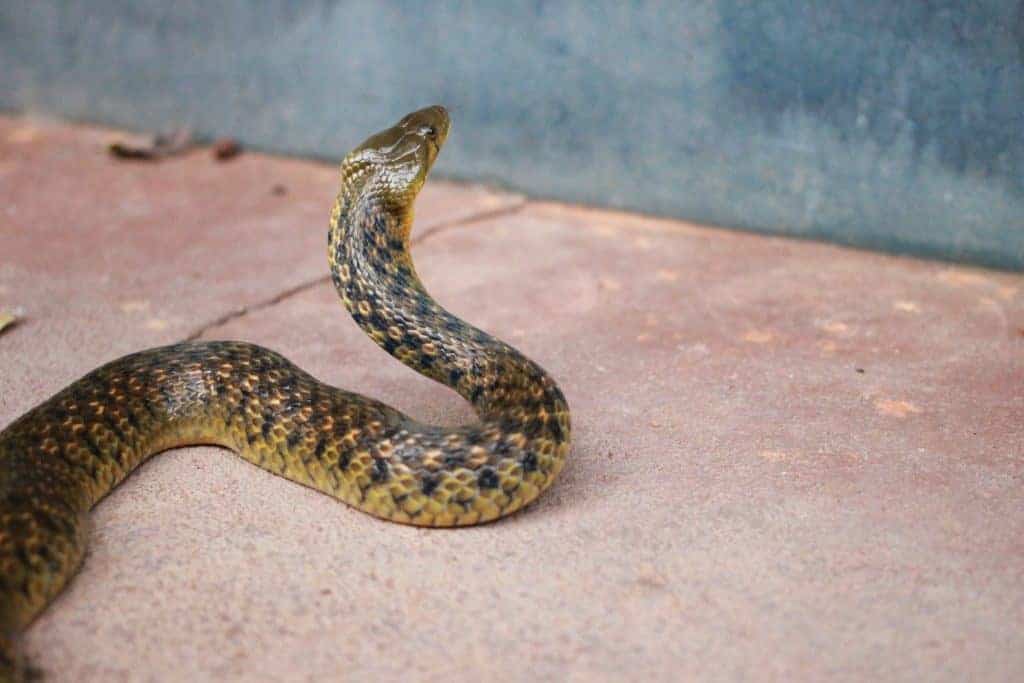
If you find an injured or sick snake, contact a wildlife rehabilitator immediately. Please do not try to pick them up with your bare hands unless you are ABSOLUTELY SURE they are not venomous. Although most snakes are not venomous, there are venomous species in every region. If you are unsure, wait until you hear back from a wildlife rehabilitator for help identifying the snake and further guidance. In the meantime, you can also download the mobile application “SnakeSnap”, which allows you to use photo identification to help identify unknown snakes in your region.
Snake Bites
Snakes prefer to avoid humans, but they will bite if they are picked up, stepped on, or provoked. If a venomous snake bites you, please seek medical attention immediately. If a non-venomous snake bites you, please wash the wound and apply an antiseptic. Even non-venomous snakes carry bacteria in their mouths that can cause a harmful infection if left untreated.
Snakes in the Winter
In addition to more obvious signs of injuries (bite wounds, road injuries, partial paralysis), snakes found outside during the winter, especially when there is snow on the ground, require immediate medical attention. Healthy snakes are not active in the winter and should be bromating in a den, burrow, tree stump, or deep cavern underground. Contact a wildlife rehabilitator for further guidance.
If you have not heard back from a wildlife rehabilitator and you must handle a non-venomous injured snake, there are a few different ways to contain them and keep them safe while you wait. It’s safest to try an indirect method first:
The “Scootch” Method
First, prepare a container with air holes on top and a tight-fitting lid. Be mindful: snakes can fit through small holes in traditional animal carriers, so make sure the air holes are smaller than the snake. Alternatively, you can use a pillowcase that can be tied off on the open end. Oftentimes, a pillowcase is preferable because the snake cannot see all the commotion going on around them while they are being transported. Place the container or pillowcase on its side near the injured snake. Then use a broom or tree branch to gently nudge the snake inside. Once they are inside, secure the lid or opening.
Salmonella
If you must handle an injured non-venomous snake with your hands, please wear thick Kevlar-lined gloves. In addition to excreting a strong-smelling musk when they are agitated, snakes can also carry strains of Salmonella in their feces. Salmonella is a bacterial disease that is very dangerous for humans.
With gloved hands, calmly approach the snake and use a long sturdy object, such as a long tree branch, to distract them away from your reaching hand. Keep the branch low to the ground near the snake’s head. Then, use your free (gloved) hand to take hold of and lift up the snake’s tail and use the branch to lift up the front part of the snake’s body. Quickly place them inside the pillowcase or sturdy container and securely fasten the lid.
Snakes are cold-blooded animals and require a heat source to maintain body temperature. Once you’ve contained the injured snake, it’s important to keep them in a warm, quiet, dark place until you hear back from a wildlife rehabilitator. Do not disturb them or repeatedly uncover and check on them. Do not let children or other companion animals near them.
Reflexive Biting After Death
If you find a dead snake, please do not handle their body unless you are absolutely sure they are non-venomous. A snake’s body is capable of reflexively “biting” several hours after death. If the snake is venomous, this means they can still inject venom into your body after they’ve died.
Baby Snakes
Uninjured baby snakes are independent from birth and do not need assistance!
Snakes with Clouded Eyes
When snakes outgrow their skin, they go through a phase called ecdysis, or shedding. In addition to shedding the skin on their body, they also shed the outer layer of their eyes, which causes their eyes to cloud over. Although this is a normal process that happens regularly, ecdysis can be stressful for snakes. Be mindful: If you notice a snake with clouded eyes, they may be more irritable during this time since their vision is severely limited. It’s best to leave them alone.
Snakes Found in an Inconvenient Location
Most snakes are active during the day and it’s common to find them in areas that are frequented by their prey (e.g. birds, mice, rats, toads, frogs, insects). Occasionally, they will make their way inside buildings in search of food and warmth. If you’re uncomfortable with their presence, there are a few ways to safely get them to leave. First, try stomping on the ground. The vibration should encourage them to leave. If they do not leave, you can confine them to one room with a door that leads outside. Open the exterior door and allow the snake time to make their way out. If they still aren’t leaving, you can use the “scootch” method and release them in a safe environment nearby. For more information on peacefully coexisting with wildlife, like snakes, check out our resource “Compassionate Wildlife Practices at Your Animal Sanctuary”.
Help! I Found a Turtle or Tortoise

If you find an injured turtle or tortoise, please contact a wildlife rehabilitator immediately. Though most turtles and tortoises can safely be picked up, some are very dangerous, and all turtle and tortoise species have the potential to carry Salmonella. Please exercise caution if you must handle a turtle or tortoise. Wear gloves and always wash your hands with soap and water after handling them.
Do Not Remove Uninjured Turtles or Tortoises From Their Territory
Turtles and tortoises are extremely territorial animals that are often forced to cross roads in Spring and Summer during breeding season in order to return to their ancestral nesting sites. If you see a turtle or tortoise in the road and they appear uninjured, you can carefully pick them up and place them on the side of the road in which they were heading so they don’t get struck by a vehicle. They have small home ranges and they should be left in the area in which they were found. Their survivability depends on it! If they are placed outside of their home range, they will have a hard time finding food and water sources and will likely spend the rest of their life trying to find their way back home. Please exercise the same care with aquatic turtle species and do not relocate them to a body of water that is different from the one in which they were found. Oftentimes, they do not have the proper immunities to survive in unknown bodies of water.
Turtle or Tortoise? Know the Difference!
Turtles are aquatic and spend some or most of their time in the water. However, it’s of the utmost importance that you do not release a turtle directly into a body of water unless you are absolutely positive they are an aquatic turtle who can swim. It’s always safest to set the turtle near the water, not in it, so they can choose whether to go in. Turtles have flatter shells and flipper-like feet for swimming. They are lighter in weight than most tortoises.
Tortoises are terrestrial and can die if put into water because they cannot swim. They have large, dome-like shells and stocky, bent legs for walking. They are usually heavier in weight than most turtles.
If you are still unsure, please contact a wildlife rehabilitator and heed their guidance.
The vast majority of injuries sustained by turtles and tortoises are the result of being struck by a vehicle, being bitten by a dog, or getting caught in fishing gear. If you notice that a turtle or tortoise has sustained an injury to their shell, please do not try to manipulate the pieces. Their shell is bone and shell fractures cause them immense pain. In these cases, please contact a wildlife rehabilitator right away and get the turtle or tortoise to a safe place. But first, write down the exact location the turtle or tortoise was found. This is critical to their survival once they are rehabilitated and ready to be released. Then, prepare a secure container with air holes (preferably plastic, metal, or rubber) and a secure lid. It you are dealing with a turtle, you can place a damp towel inside. With gloved hands, gently pick the turtle or tortoise up with one hand on the back of their shell and the other underneath, and place them inside the container. Please be mindful: turtles and tortoises can bite, scratch, and urinate when they feel threatened. It’s best to avoid placing your fingers anywhere near their head. Once you’ve contained them, it’s important to keep them in a warm, quiet, dark place until you hear back from a wildlife rehabilitator. Do not disturb them or repeatedly uncover and check on them. Do not let children or other companion animals near them.
Snapping Turtles
Please exercise extreme caution if you are dealing with a snapping turtle. They are very large turtles with long necks, long tails, and extremely powerful jaws that can seriously injure you if you don’t handle them carefully. If you must pick up a snapping turtle, please avoid handling the front half of their body. While wearing gloves, place one hand on the back of the turtle’s shell and slide the other hand halfway under their shell. DO NOT put your hands or body anywhere near their mouths.
Help! I Found a Frog or Toad
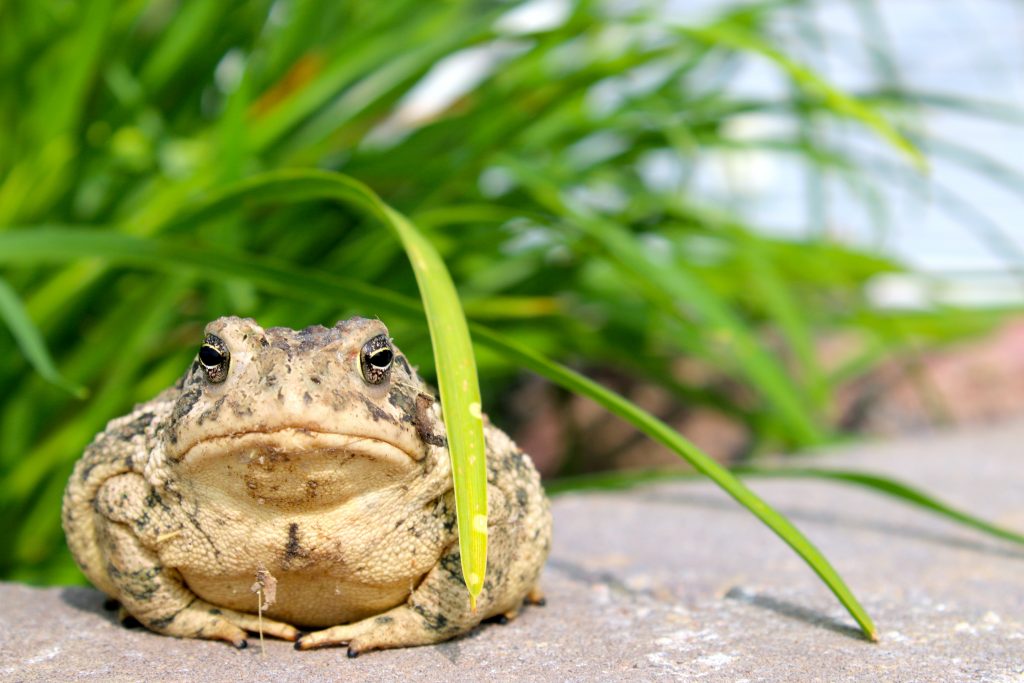
If you find an injured frog or toad, please contact a wildlife rehabilitator immediately. Though it is generally safe to pick up frogs and toads, it is highly recommended that you wear disposable gloves and always wash your hands after handling them. In addition to having the potential to carry Salmonella, frogs and toads secrete toxins through their skin. Toads also have special glands behind their eyes that secrete a milky-white substance when they’re agitated. Though most of the toxins are mild to humans, they can be harmful if they are accidentally ingested. Wearing gloves is also important for the safety of the toads and frogs, as they can absorb harmful chemicals from your hands into their skin.
Has One of Your Sanctuary Residents Put a Toad in Their Mouth?
If you know one of your sanctuary residents put a toad in their mouth, please take them to a veterinarian immediately. The poison in the milky-white substance from the glands behind their eyes can be lethal for many species.
Though they sometimes get a bad rap, the presence of frogs and toads is actually an indicator of a very healthy ecosystem. They are unable to live in polluted habitats and are very sensitive to changes in their environment, so seeing them on your property is usually a good sign! However, as a general guideline, if you see a frog or toad sitting in an open, sun-exposed spot during the day, there’s a good chance they need medical attention from a wildlife rehabilitator. Frogs and toads often need medical attention because of trauma from vehicle collisions, domesticated animal attacks, chemical burns, or lawnmower accidents.
Toads Crossing Roads!
During late Winter and early Spring, thousands of amphibians (toads, frogs, salamanders, newts) migrate to their ancestral breeding pools. Oftentimes, their migration takes them across roads where they are at a very high risk of being struck by a vehicle. If you are near a site where a lot of amphibians are dying on roads, please contact your local conservation organization and see if they offer any assistance or resources on helping amphibians migrate safely. Many of these groups coordinate volunteers each year who physically help amphibians safely cross these roads. If you see an amphibian in the road and they appear uninjured, you can carefully pick them up and place them on the side of the road in which they were heading so they don’t get struck by a vehicle. Please be careful – your safety comes first!
In most cases, with the right care, frogs and toads have amazing healing capabilities and can recover from injuries fairly well! While you are waiting for a wildlife rehabilitator, you can carefully contain the frog or toad. First, prepare a small plastic container with air holes in the lid and put a clean damp cloth on the bottom. Wearing disposable gloves, gently pick up the frog or toad by their body, place them inside the container, and secure the lid. Please do not pick them up by their head or limbs, as this can injure them. Be mindful that frogs and toads are afraid of humans and will try to hop out of your grip! Once you’ve contained the injured frog or toad, it’s important to keep them in a warm, quiet, dark place until you hear back from a wildlife rehabilitator. Do not disturb them or repeatedly uncover and check on them. Do not let children or other companion animals near them.
Found a Swollen Toad or Frog?
Female amphibians become noticeably swollen when they are carrying eggs, but they usually return to their normal size once they release them. As a defense mechanism, toads and frogs will also sometimes inflate themselves so they can appear too big for predators to eat. They will deflate themselves when they feel safe again. If you find a swollen toad or frog that is not pregnant or inflated for defensive purposes, it’s possible that they have an intestinal blockage or an infection that’s caused them to absorb too much water. As always, if you are unsure, contact a wildlife rehabilitator so they can give you proper guidance.
Rabies-Vector Species (RVS): Wild Animals that Pose a Higher Risk of Rabies Transmission

If you have found an orphaned, sick or injured raccoon, groundhog, skunk, fox, coyote, or bat that is still alert to your presence and can readily move around, please DO NOT TOUCH THIS ANIMAL with your bare hands. Contact a licensed wildlife rehabilitator immediately. All these species are considered to be rabies-vector species, which means they are the most common wildlife species that transmit rabies to other animals, including humans. Although it is rare in the U.S., rabies is a very dangerous viral disease that is usually spread through the affected animal’s saliva and enters another animal through a break in the skin or contact with the eyes, nose or mouth. From there, it spreads to the nervous system and, in most cases, leads to death. If you have find a wild mammal that is exhibiting abnormal behavior (e.g. walking up to or not exhibiting fear towards humans, circling, seeming unaware of where they are), unfortunately, these behaviors are common signs of rabies.
Bare-handed Contact and Rabies Testing
While the rabies virus is usually spread through a scratch or bite wound, any bare-handed contact you have with a rabies-vector species is considered potential exposure. Unfortunately, the only way to test if an animal has rabies is through testing of their brain tissue. Therefore, if you have any bare-handed contact or are scratched or bitten by a rabies-vector species, that animal will have to be euthanized for rabies testing and you should seek medical attention immediately.
RVS Rehabilitation
Rehabilitating rabies-vector species requires a special RVS license and is prohibited in some regions.
Help! I Found a Raccoon (RVS)

If you find an injured or sick raccoon, please contact a wildlife rehabilitator immediately. Do not attempt to handle, feed, or transport them. Adult raccoons move quickly and can be very aggressive and cause serious injury to humans when they feel threatened. Raccoons are a rabies-vector species and they should only be handled and transported by people who are vaccinated against the rabies virus and licensed wildlife rehabilitators.
Raccoons During the Day – Don’t Panic!
Although raccoons are primarily active at night, they sometimes look for food during the day, especially if food is scarce or they have babies to feed. So, if you see a raccoon moving about during the day, don’t panic! Unless they’re acting strangely, (e.g. circling or walking up to you unafraid), they are likely perfectly healthy individuals going about their day.
Raccoons Stuck on Your Property
If you find a raccoon who is stuck in a dumpster or other space on your property and cannot get out, you can lower a branch or knotted rope into the space, secure it, and wait for them to crawl out when they feel safe. If they are not out by the next day, contact a wildlife rehabilitator for guidance.
If you must handle an injured raccoon that is unresponsive, immobile, or in need of immediate assistance, please prepare and protect yourself first. It is still highly recommended to call a wildlife rehabilitator and wait for their response. It is of utmost importance to protect yourself and call people who are vaccinated against the rabies virus and professionally trained to handle rabies-vector species. When dealing with raccoons, you must wear a thick pair of gloves (Kevlar-lined preferably), thick jacket, and any other available protection that will help prevent injury to your body. Have a large towel and sturdy animal carrier or container with air holes ready to place the raccoon in. Appropriately-sized trash cans, recycling bins, and plastic containers with sealable lids and air holes can also work. Line the container with old soft shirts or blankets. Do not use towels to line the bottom. Raccoons have long sharp nails that can easily get caught in them. First, try the “scootch” method of capture:
The “Scootch” Method
Place a sturdy carrier or container on its side near the injured raccoon. Then use a broom or tree branch to gently nudge the raccoon inside the container. Once they are inside, find a safe way to secure the lid.
If you must handle a raccoon with your hands, carefully approach them from behind and drop the towel over top of their head and body. Quickly gather them in the towel, place them into the container, take off the towel, and securely fasten the lid so they cannot escape. Once you’ve contained them, secure the container’s lid and put them in a warm, dark, quiet place until a wildlife rehabilitator can take them. Handle them as little as possible. Do not disturb them or repeatedly uncover and check on them. No matter how kind you are, any human handling is extremely stressful for them. Do not let children or other companion animals near them.
BE VERY CAREFUL NOT TO GET BITTEN, LICKED, OR SCRATCHED!
Please be mindful not to get bitten, licked, or scratched by a raccoon. If you are bitten or their saliva has gotten into your eyes, nose, or mouth, please seek medical attention immediately. In addition to carrying rabies, raccoons are also carriers of the roundworm Baylisascaris procyonis. Although Baylisascaris is not usually detrimental for raccoons, it poses a significant risk to both humans and other nonhuman animals. The eggs of Baylisascaris are present in raccoon feces and are able to stick to the fur and skin of other animals, including humans. Once on the skin, the only practical way to remove the eggs is with bleach. However, bleach will not kill the eggs. Only open flame or steam can kill them. If Baylisascaris eggs are ingested, they become larvae in the intestines and migrate throughout the host’s body. Once they find their way into the eye, enucleation (removal of the eye) is the only treatment. Unfortunately, if they make their way to the brain, this condition is fatal.
Help! I Found a Skunk (RVS)
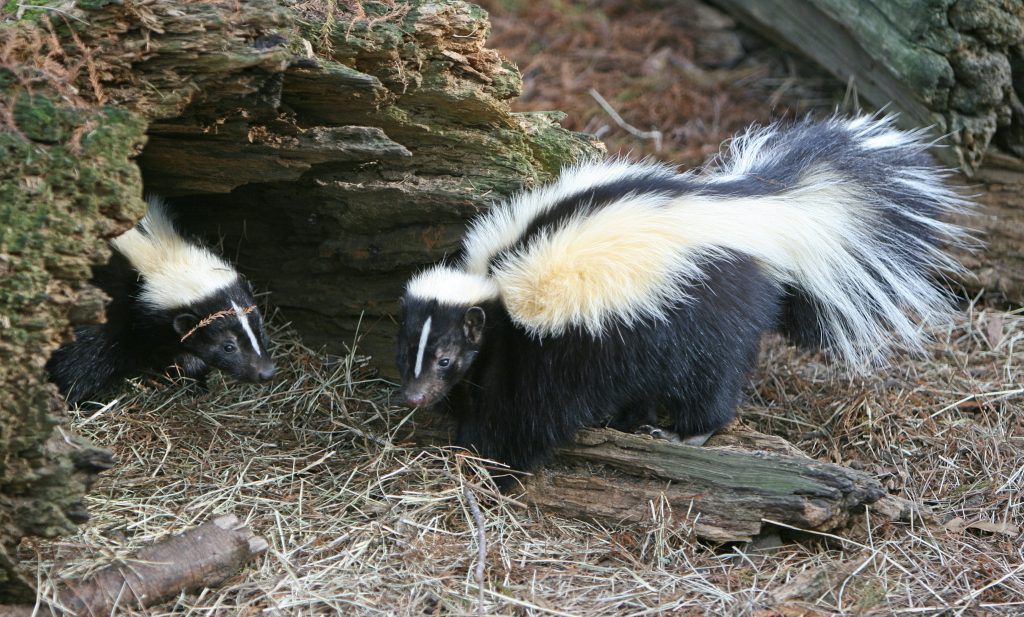
If you find an injured or sick skunk, please contact a wildlife rehabilitator immediately. While not all skunks carry the rabies virus, the skunk family is considered a rabies-vector species and they can carry rabies for a long time before exhibiting any symptoms. Female skunks can also pass the virus on to their babies, so please DO NOT attempt to handle, feed, or transport them on your own. They should only be handled and transported by people who are vaccinated against the rabies virus and licensed wildlife rehabilitators.
Skunks During the Day – Don’t Panic!
Although skunks are primarily active at night, they sometimes look for food during the day, especially if food is scarce or they have babies to feed. So, if you see a skunk moving about during the day, don’t panic! Unless they’re acting strangely around humans (e.g. circling or walking up to you without fear), they are likely perfectly healthy individuals going about their day.
If you must handle an injured skunk that is unresponsive, immobile, or in need of immediate assistance, please prepare and protect yourself first. It is still highly recommended to call a wildlife rehabilitator and wait for their response. It is of utmost importance to protect yourself and call people who are vaccinated against the rabies virus and professionally trained to handle rabies-vector species. When dealing with skunks, you must wear a thick pair of gloves (Kevlar-lined preferably), thick jacket, and any other available protective clothing that will help prevent injury to your body. Although they are usually very docile animals, threatened and/or injured adult skunks can move quickly and are very strong. Have a large towel and sturdy animal carrier or container with air holes ready to place the skunk in. Appropriately-sized trash cans, recycling bins, and plastic containers with sealable lids and air holes can also work. Line the container with old soft shirts or blankets. Do not use towels to line the bottom – skunks have claws that can easily get caught in them. First, try the “scootch” method of capture:
The “Scootch” Method
Place a sturdy carrier or container on its side near the injured skunk. Then use a broom or tree branch to gently nudge them inside the container. Once they are inside, find a safe way to secure the lid.
If you must handle a skunk with your hands, carefully and slowly approach them from behind and drop the towel over top of their head and body. Quickly gather them in the towel, place them into the container, take off the towel, and securely fasten the lid so they cannot escape. Once you’ve contained them, put them in a warm, dark, quiet place until a wildlife rehabilitator can take them. Handle them as little as possible. Do not disturb them or repeatedly uncover and check on them. No matter how kind you are, any human handling is extremely stressful for them. Do not let children or other companion animals near them.
BE VERY CAREFUL NOT TO GET BITTEN, LICKED, SCRATCHED, OR SPRAYED!
If you are bitten by a skunk or their saliva has gotten into your eyes, nose, or mouth, please seek medical attention immediately. While rabies is the main concern, skunks are also known for their ability to spray a pungent sulfur-containing liquid from their anus when they are frightened. BE AWARE: They are extremely near-sighted and startle easily, so any fast movements or loud noises will make them spray. Fortunately, skunks will usually warn you first before they spray by stomping their feet. However, if they feel threatened enough, they will spray you multiple times and aim for your eyes.
Got Sprayed?
The good news is you cannot get rabies from skunk spray. The bad news is, skunk spray can be very challenging to remove. For ideas on how to safely remove skunk spray, check out this external resource from the University of Nebraska’s Wildlife Extension.
Help! I Found a Groundhog (RVS)

If you find an injured or sick groundhog, please contact a wildlife rehabilitator immediately. Although it is very rare to come across a rabid groundhog, the groundhog family is more susceptible to this disease, so please DO NOT attempt to handle, feed, or transport them on your own. They should only be handled and transported by people who are vaccinated against the rabies virus and licensed wildlife rehabilitators.
If you must handle an injured groundhog that is unresponsive, immobile, or in need of immediate assistance, please prepare and protect yourself first. It is still highly recommended to call a wildlife rehabilitator and wait for their response. It is of utmost importance to protect yourself and call people who are vaccinated against the rabies virus and professionally trained to handle rabies-vector species.
When dealing with groundhogs, you must wear a thick pair of gloves (Kevlar-lined preferably), thick jacket, and any other available protective clothing that will help prevent injury to your body. Although they are usually very timid towards humans, threatened and/or injured adult groundhogs can become aggressive. They have extremely strong jaws and sharp teeth! Have a large towel and sturdy animal carrier or container with air holes ready to place the groundhog in. Appropriately-sized trash cans, recycling bins, and plastic containers with sealable lids and air holes can also work. Anything that is made from cardboard or wood is not recommended for groundhogs. Line the container with old soft shirts or blankets. Do NOT use towels to line the bottom. Groundhogs have claws that can easily get caught in them. First, try the “scootch” method of capture:
The “Scootch” Method
Place a sturdy carrier or container on its side near the injured groundhog. Then use a broom or tree branch to gently nudge the groundhog inside the container. Once they are inside, find a safe way to secure the lid.
If you must handle a groundhog with your hands, carefully approach the groundhog from behind and drop the towel over top of their head and body. Quickly gather them in the towel, place them into the container, take off the towel, and securely fasten the lid so they cannot escape. Once you’ve contained them, put them in a warm, dark, quiet place until a wildlife rehabilitator can take them. Handle them as little as possible. Do not disturb them or repeatedly uncover and check on them. No matter how kind you are, any human handling is extremely stressful for them. Do not let children or other companion animals near them.
BE VERY CAREFUL NOT TO GET BITTEN, LICKED, OR SCRATCHED!
Please be mindful not to get bitten, licked, or scratched by a groundhog. If you are bitten by a groundhog or their saliva has gotten into your eyes, nose, or mouth, please seek medical attention immediately.
Help! I Found a Fox (RVS)

If you find an injured or sick fox, please contact a wildlife rehabilitator immediately. Do not attempt to approach, handle, feed, or transport them. Adult foxes are predators and consider humans to be predators as well. Though foxes are naturally elusive and timid towards humans, they can be very aggressive and cause serious injury if they feel threatened. They should only be handled and transported by people who are vaccinated against the rabies virus and professionally trained and licensed to handle foxes. In addition to being carriers of the rabies virus, foxes are carriers of other harmful diseases and parasites that are transmissible to humans. Please watch over the fox from a distance and be patient as you wait for a wildlife rehabilitator to arrive.
Finding a Fox Rehabilitator
If you are having any trouble contacting a local wildlife rehabilitator who is licensed to take in foxes, you can contact Amy Shutt, the director of The Canid Project and Louisiana state-permitted wildlife rehabilitator specializing in Red Foxes and Gray Foxes. She has a list of licensed wildlife rehabilitators who take in foxes in every U.S. state and can help you find one in your area. Email thecanidproject@gmail.com or call her at 1-866-REDFOX1.
BE VERY CAREFUL NOT TO GET BITTEN, LICKED, OR SCRATCHED!
Please be mindful not to get bitten, licked, or scratched by a fox. If you are bitten by a fox or their saliva has gotten into your eyes, nose, or mouth, please seek medical attention immediately.
Foxes During the Day – Don’t Panic!
Although foxes are primarily active at night, they sometimes hunt for food during the day, especially if food is scarce or they have babies to feed. So, if you see a fox moving about during the day, don’t panic! Unless they’re acting strangely around you (e.g. circling or walking up to humans unafraid), they are likely healthy individuals going about their day.
Help! I Found a Coyote (RVS)
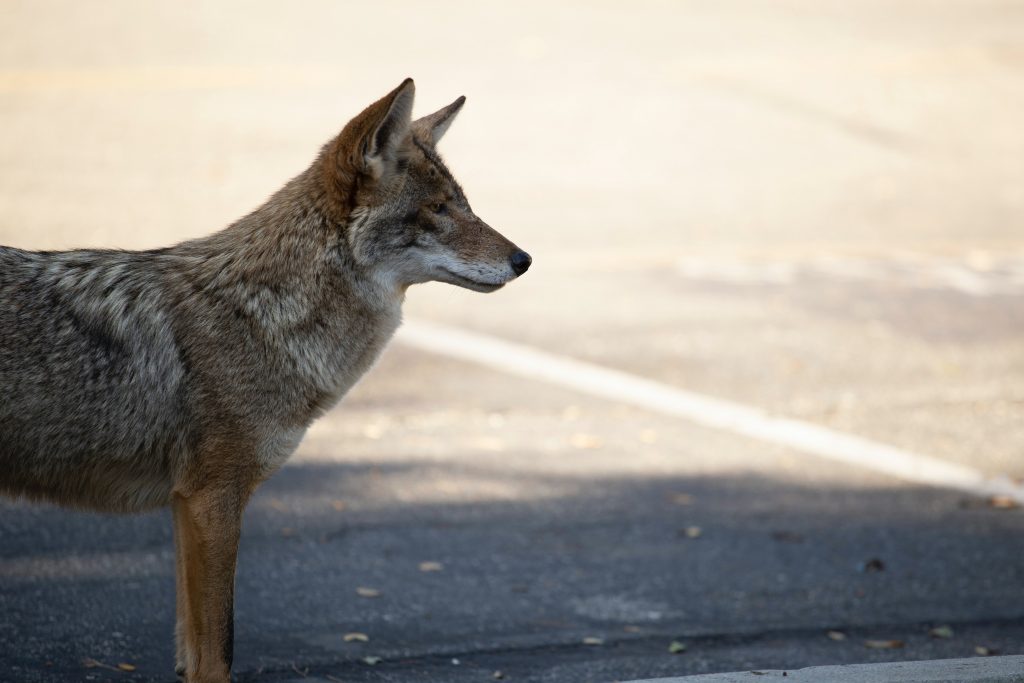
If you find an injured or sick coyote, please contact a wildlife rehabilitator immediately. Do not attempt to approach, handle, feed, or transport them. Adult coyotes are predators and consider humans to be predators as well. Though coyotes are naturally elusive and timid towards humans, they can be very aggressive and cause serious injury if they feel threatened. They should only be handled and transported by people who are vaccinated against the rabies virus and professionally trained and licensed to handle coyotes. In addition to being carriers of the rabies virus, coyotes are carriers of other harmful diseases and parasites like sarcoptic mange and distemper. Please watch over the coyote from a distance and be patient as you wait for a wildlife rehabilitator to arrive.
Finding a Coyote Rehabilitator
If you are having trouble contacting a local wildlife rehabilitator who is licensed to take in coyotes, you can try contacting The Canid Project for a list of licensed wildlife rehabilitators who take in coyotes in your state. Email the canidproject@gmail.com.
Coyotes During the Day – Don’t Panic!
Although coyotes are primarily active at night, they sometimes hunt during the day, especially if food is scarce or they have babies to feed. So, if you see a coyote moving about during the day, don’t panic! Unless they’re acting strangely (e.g. circling or walking up to you), they are likely healthy individuals going about their day.
BE VERY CAREFUL NOT TO GET BITTEN, LICKED, OR SCRATCHED!
Please be mindful not to get bitten, licked, or scratched by a coyote. If you are bitten by a coyote or their saliva has gotten into your eyes, nose, or mouth, please seek medical attention immediately.
Help! I Found a Bat (RVS)
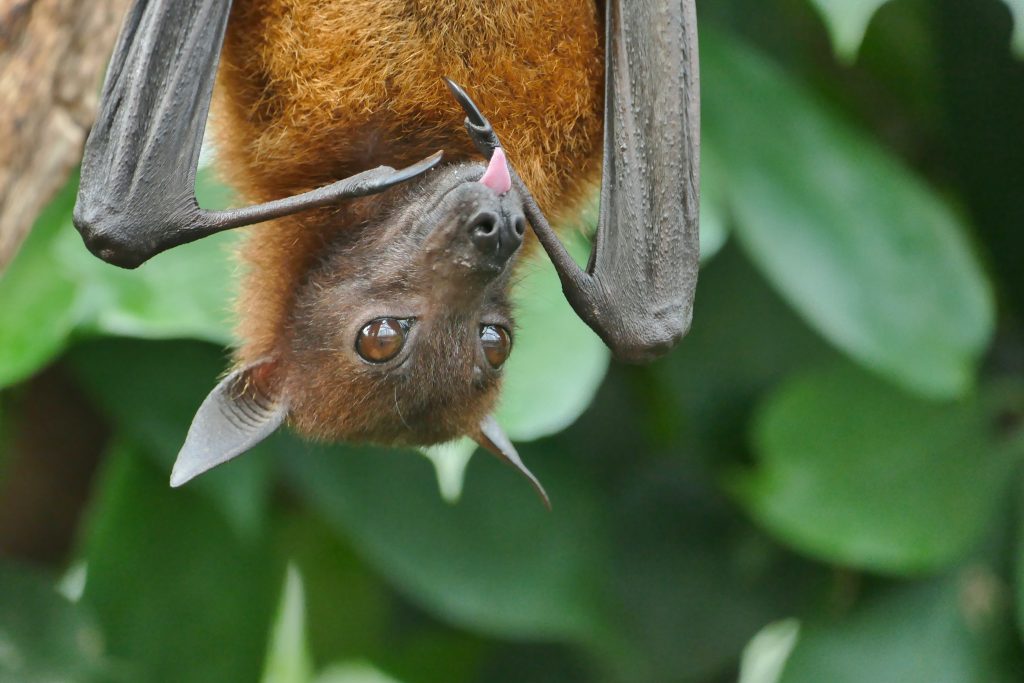
If you find an injured bat, please contact a wildlife rehabilitator immediately. Do not attempt to handle, feed, or transport them. Although less than one half of one percent of bats contract the rabies virus, they are considered to be a higher-risk species and should only be handled and transported by licensed wildlife rehabilitators who are vaccinated against the rabies virus and professionally trained to handle them. If you must handle a bat that is in need of immediate assistance, please prepare and protect yourself first. It is still highly recommended to call a wildlife rehabilitator and wait for their response. It is of utmost importance to protect yourself.
When dealing with bats, there are a few common scenarios you may find them in. Here are the most common scenarios and steps you can take to address them:
Bats Flying Around During the Day Time – Don’t Panic!
Most bats are nocturnal, but it is possible to see some species flying around early in the morning or late in the afternoon to try and catch insects. This is completely normal behavior and nothing to be alarmed about!
Bats Found Hanging from a Wall or Tree
If you see a bat hanging on the side of a wall or tree, they are most likely just sleeping. However, if you are unsure and suspect they may be ill or injured, keep an eye on them until the next morning. If the bat hasn’t left yet, you can safely assume they need help and you should contact a licensed RVS wildlife rehabilitator for assistance.
Bats Found Inside a Building – Don’t Panic!
Most bats found flying around inside a building are lost juveniles or migrating and feeling a bit disoriented. There’s no need to panic. You can easily help them find their way back outside by closing off all the other rooms in your building, opening all the doors and windows that lead outside, turning off all the lights inside, and shining a flashlight beam out of one of the open doors. Leave the bat for a few hours to see if they leave on their own. If they do not, you can safely assume they need help and you should contact a licensed RVS wildlife rehabilitator.
Do NOT Try to Catch Them
If the bat is flying around inside your building, please do not try to catch them. If you are not trained to handle bats, there is a good possibility that you will injure them or they will injure you. Oftentimes, bats that are caught while flying feel more threatened and are more likely to try to bite you in defense. Please be patient and wait to see if they leave on their own.
Bats Found on the Ground
If you find a bat lying on the ground, it is usually either a baby bat who fell and needs help or an adult who became grounded and is having a hard time taking off again. Most bats need a vertical drop that is at least eight or more feet from the ground in order to take off. If you feel confident that you can safely move the bat to a tree branch without physically touching them or injuring them, you must first protect yourself and wear a think pair of gloves (Kevlar-lined preferably), thick jacket, and any other available protection that will help prevent injury to your body. Wait until the bat is motionless, then quietly approach them and throw a small cloth over top of them. Quickly gather them up, holding them gently but firmly. Before you place them on a tree branch, make sure there are no predators around (e.g. owls, hawks, blue jays, snakes, raccoons). Then, gently drape the towel over a tree branch, allowing the bat’s feet to touch and instinctively grip the branch with their toes. If the bat is still on the same tree branch or in the same position the following day, you can safely assume they need help and you should contact a licensed RVS wildlife rehabilitator.
If you find a bat that does not or cannot fly away, they are likely suffering from an injury, illness, dehydration, or starvation. If this is the case, please contact an RVS licensed wildlife rehabilitator immediately. If you must handle an injured bat, please protect yourself first and wear a thick pair of gloves, thick jacket, and any other available protection that will help prevent injury to your body. There are a few different ways to contain bats, but it’s safest try an indirect method first:
The “Spider” Method
First, gather a small sturdy container (e.g. shoebox, Tupperware, waste can, coffee can) with several small air holes, a small cloth or soft old shirt, and tight-fitting lid. Approach the bat calmly and quietly until you are close enough to place the container over top of them. Be mindful of their delicate wings! Then gently slide the lid up from the bottom of the container, carefully turn the container right side up and secure the lid. You can leave a soft cloth in the container to give the bat something to cling to.
If you are unable to contain the bat with the “spider” method, you can simply throw a soft cloth over top of their head and body, gently scoop them up, and place them in a small sturdy container (e.g. shoebox, Tupperware, waste can, coffee can) with several small air holes and a tight-fitting lid. Please do not place the bat in a bird cage or container with openings that are wider than a pencil. Bats can find their way out of very tight spots! If you decide to use a cardboard box, please make sure you tape up all the seams so they are tight and secure.
Once you’ve contained the bat, put them in a warm, dark, quiet place until a wildlife rehabilitator can take them. Do not handle or repeatedly disturb them. Do not let children or other companion animals near them.
BE VERY CAREFUL NOT TO GET BITTEN, LICKED, OR SCRATCHED!
Sick bats do not seek people out to attack them. However, if you are bitten by a bat or their saliva has gotten into your eyes, nose, or mouth, please seek medical attention immediately. Never handle a bat with your bare hands. Many states will automatically euthanize a bat that was handled with bare hands.
Help! I Found a Marine Mammal or Sea Turtle
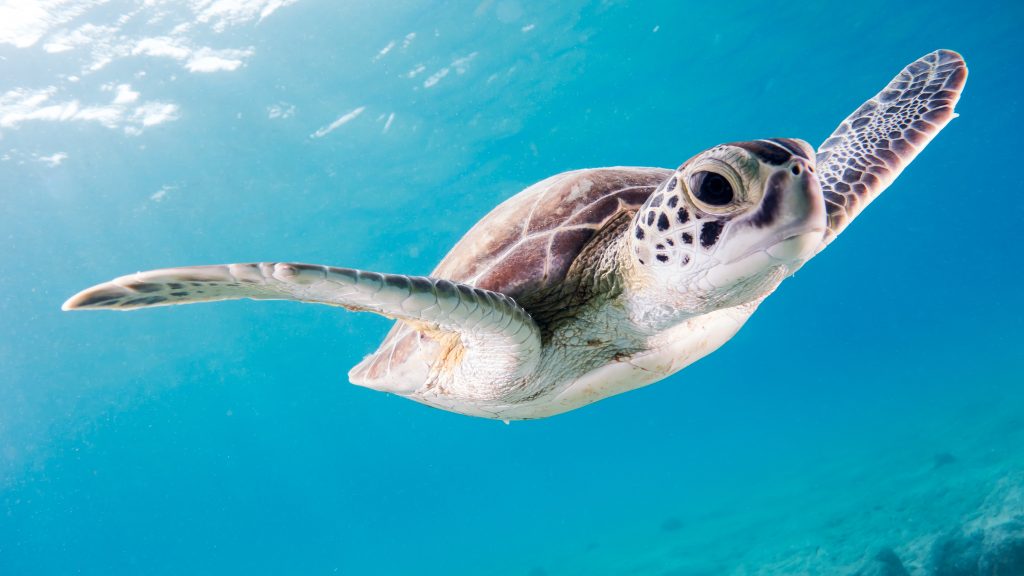
If you see a sick, injured, entangled, stranded, or dead sea turtle or marine mammal, please do not attempt to approach, handle, feed, or transport them. Please report the incident as soon as possible to the National Oceanic and Atmospheric Administration’s Marine Mammal Health and Stranding Response Program (NOAA) and wait for their guidance. When you call, provide as much information as you can, including your name, number, the date, photos, a GPS location of the animal, and the condition of the animal. Sea turtles and marine mammals are protected by state and federal laws like the Endangered Species Act and the Marine Mammal Protection Act. It is illegal to feed, injure, or kill marine mammals and sea turtles. If you see any potential violations, please report it immediately to the NOAA Fisheries Enforcement Hotline at 800.853.1964. You may report violations anonymously.
Important Reminders When You’re Dealing with Wild Animals in Distress

Protect Yourself First! Always Wear Gloves. Disinfection is Essential.
It is of utmost importance that you put your and your sanctuary’s safety first. Call a professionally trained and licensed wildlife rehabilitator to help you handle the situation before you react. Whenever possible, please do not touch wild animals with your bare hands. In addition to carrying potentially transmissible diseases, wild animals also carry ticks, fleas, mites, lice, and other parasites that can harm humans and farmed animalsA species or specific breed of animal that is raised by humans for the use of their bodies or what comes from their bodies.. However, if you must handle them with your bare hands or with gloves, thoroughly wash your hands after. It’s also very important to disinfect every piece of your equipment the wild animal has touched. If you get bitten, scratched, or licked by a wild animal, please seek medical attention immediately.
“Keep Wild, Wild” and Handle Them as Little as Possible
Petting, stroking, singing, or talking to a wild animal can kill them from stress. Keep children, companion animals, farmed animals, crowds, and loud noises away from them. They do not find any of these things comforting. Please remember these are wild animals and it is in their best interest to keep them that way. Habituating them in any way is putting their lives at risk. Whenever possible, the goal in wildlife rehabilitation is always to release them so they can be free.
Do NOT Feed Them
If you find a wild animal in distress, you may feel inclined to give them something to eat. However, providing food to an animal who is dehydrated, starving, or suffering from trauma can cause them serious harm. Their bodies may not be strong enough to digest food, particularly if it is the wrong kind of food, which can quickly cause diarrhea and in the worst cases, death. It’s more important to stabilize the animal first by keeping them warm and calm.
Do NOT Give Them Anything to Drink
It may sound counterintuitive but giving water to a wild animal in distress can also cause them serious harm. Unless you are properly trained to do so, please NEVER try to force-feed water to an animal. The water can end up in their lungs and cause pneumonia and death. Similarly, providing a water-filled bowl to wild animals in distress can put them at risk. If they are having trouble standing or panicking and trying to escape temporary confinement, they can fall into the water bowl and get hypothermia or drown.
Note Where You Found Them
This is vital information for the release of rehabilitated wild animals. Their survivability depends on being returned to their home range!
Wildlife Contact with Cats and Dogs
Cats have mouths that are full of harmful bacteria that can kill wild animals very quickly. If you see a wild animal that has been in the mouth of a cat, please contact a wildlife rehabilitator immediately. Regardless of visible wounds, the wild animal will likely need medication to survive an impending infection. If you see a wild animal that has been in the mouth of a dog, please contact a wildlife rehabilitator immediately. Dogs have powerful jaws that can cause serious injuries.
Do NOT Trap and Relocate Wild Animals
Please remember many wild animals have relatively small home ranges that they depend on for survival. Relocating them is putting their lives at risk. Relocation also severely impacts baby wild animals. Wildlife rehabilitators receive hundreds of baby wild animals in distress each year because their mothers have been needlessly trapped, relocated, and separated from them. If you are uncomfortable with the presence of wild animals near or on your property, please check out our “Compassionate Wildlife Practices at Your Animal Sanctuary” resource for tips on coexisting with them peacefully!
There Are Exceptions to These Guidelines
It is always best to heed the guidance of your local licensed wildlife professionals. For example, if they tell you it is OK to give a wild animal in distress some water, then they have determined in your particular case that it is safe to do so.
Sources
Austin Area Wildlife Rehabilitation, Inc.
Australian Wildlife Rehabilitation Conference
Central Mississippi Turtle Rescue
Maryland Raptor Conservation Center
National Oceanic and Atmospheric Administration
National Wildlife Rehabilitators Association
Rideau Valley Wildlife Sanctuary
Squirrelmender Wildlife Rehabilitation
The Wildlife Center of Virginia
University of Illinois Urbana-Champaign College of Veterinary Medicine Wildlife Medical Clinic








